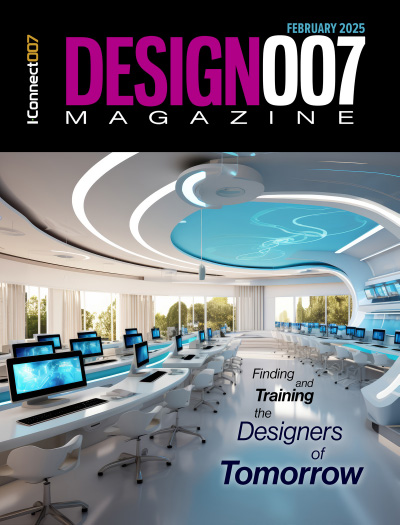-

- News
- Books
Featured Books
- design007 Magazine
Latest Issues
Current Issue
Designing Through the Noise
Our experts discuss the constantly evolving world of RF design, including the many tradeoffs, material considerations, and design tips and techniques that designers and design engineers need to know to succeed in this high-frequency realm.

Learning to Speak ‘Fab’
Our expert contributors clear up many of the miscommunication problems between PCB designers and their fab and assembly stakeholders. As you will see, a little extra planning early in the design cycle can go a long way toward maintaining open lines of communication with the fab and assembly folks.

Training New Designers
Where will we find the next generation of PCB designers and design engineers? Once we locate them, how will we train and educate them? What will PCB designers of the future need to master to deal with tomorrow’s technology?
- Articles
- Columns
Search Console
- Links
- Media kit
||| MENU - design007 Magazine
Stop Relating Trace Temperature to Current Density
October 1, 2020 | Douglas G. Brooks, PhDEstimated reading time: 1 minute
Many design engineers and even many software suppliers make the significant mistake of equating changes in trace or via temperature with current density. This is incorrect at best and dangerous at worst. There is little if any correlation between temperature and current density. Current and trace dimensions (among other things) are the relevant variables, but current density is not. I hope by the end of this article you will see why. Here are four illustrations that will help you understand this.
1. Current Density Is Not an Independent Measure
We can understand that the change in trace (and via) temperatures are a function of other variables. Thus, we can formulate the following as two possible relationships (all other things equal). Let:
C = current
J = current density
w = trace width
th = trace thickness
?T = change in trace temperature
Then, we can suggest the following:
Equation 1: ?T = fn(C, w, th)
Equation 2: ?T = fn(J, w, th)
Now, the question is, “Are both of these relationships true, or, if not, is either one true?” We know from the extensive experimental evaluations reported in IPC-2152 that Equation 1 is true, so is Equation 2 also true? From Equations 1 and 2, it follows that:
Equation 1a: C = fn(?T, w, th)
Equation 2a: J = fn(?T, w, th)
To read this entire article, which appeared in the September 2020 issue of Design007 Magazine, click here.
Suggested Items
IPC Excellence in Education Award: Zenaida Valianu
05/01/2025 | Nolan Johnson, I-Connect007Zenaida Valianu is the training manager at IPC who brings more than 25 years of expertise in standards and training development to her role. She has revolutionized IPC certification training programs by significantly enhancing their content with comprehensive curricula and engaging materials. She has also been instrumental in developing essential workforce training courses and contributing to various other initiatives.
A Visit With ‘Flexperts’ Mark Finstad and Nick Koop
05/01/2025 | Joe Fjelstad, Verdant ElectronicsAt IPC APEX EXPO 2025, I chatted with seasoned flex experts Mark Finstad and Nick Koop about "Flexperts" and their roles as leading educators and in the realm of standards development for this increasingly indispensable electronic interconnection technology. They have been teaching about lessons learned and how to successfully navigate the “seas” of flexible circuits to help their students avoid the hazards that have taken down many of their predecessors in the past.
Real Time with... IPC APEX EXPO 2025: Improving the Electronics Industry With Advanced Packaging
04/30/2025 | Real Time with...IPC APEX EXPODevan Iyer, the Chief Strategist for Advanced Packaging at IPC, shares insights from his recent presentation at the EMS Leadership Summit. The discussion covers the importance of understanding market segments in IoT, power electronics, and high-performance computing. EMS companies are encouraged to specialize, invest wisely, and collaborate to meet customer needs.
Real Time with... IPC APEX EXPO 2025: The Role of AI in Advanced Packaging
04/30/2025 | Real Time with...IPC APEX EXPOIn a follow-up to his keynote, Dr. Ahmad Bahai, discusses the critical intersection of advanced packaging, computing, and AI in semiconductor innovation with Nolan Johnson and Devan Iyer. He emphasizes the need for new approaches to handle the data economy and highlights AI's role in optimizing electronics manufacturing. The conversation covers challenges in power and thermal management, the impact of AI on EDA tools, and bio-inspired innovations. Predictions about future trends point towards increased efficiency in design and manufacturing.
New IPC Standard Sets First Global Benchmark for E-Textile Wearable Reliability
04/29/2025 | IPCIPC announces the release of IPC-8981, Quality and Reliability of E-Textile Wearables. This first-of-its-kind standard sets baselines for testing and classifying e-textile wearables, addressing key challenges in product reliability, performance, and quality assurance.


